|
|

|
|
Author
|
Topic: Intuitive Machines IM-1 Nova-C lunar mission
|
Robert Pearlman
Editor Posts: 51987
From: Houston, TX
Registered: Nov 1999
|
 posted 10-02-2019 01:55 PM
posted 10-02-2019 01:55 PM
   
Intuitive Machines release Intuitive Machines selects SpaceX to launch Nova-C to the Moon in 2021 on a Falcon 9 rocketHouston-based Intuitive Machines selected SpaceX to launch its lunar lander, Nova-C, to the Moon in 2021 on a Falcon 9 rocket. "Intuitive Machines is thrilled to sign with SpaceX to take Nova-C on its first mission to the moon," said Intuitive Machines President and CEO, Steve Altemus. "SpaceX's ability to make low-cost quality lunar transport is paramount to completing NASA's Commercial Lunar Payload Services (CLPS) contract and Intuitive Machines becoming the first commercial company to land on the Moon." NASA awarded Intuitive Machines the first mission task order under the CLPS contract, May 31, 2019. It calls for Intuitive Machines to develop, launch and land Nova-C on the lunar surface with a payload of NASA-provided instruments that will conduct science investigations and demonstrate advanced technologies on the lunar surface. Intuitive Machines reviewed proposals from multiple launch providers and ultimately selected SpaceX for its proven record of reliability and outstanding value. Nova-C will launch on a Falcon 9 rocket from historic Launch Complex 39A at NASA's Kennedy Space Center in Florida. "We're honored that Intuitive Machines selected Falcon 9, SpaceX's tried and true workhorse, for this pioneering mission to the Moon, said Gwynne Shotwell, president of SpaceX. "Our partnership with Intuitive Machines is a great example of two private companies working together with NASA to advance space exploration." |
Robert Pearlman
Editor Posts: 51987
From: Houston, TX
Registered: Nov 1999
|
 posted 04-13-2020 09:53 AM
posted 04-13-2020 09:53 AM
   
Intuitive Machines release Launch Date and Landing Site Selected For 2021 Moon MissionIntuitive Machines engineers selected an area in Oceanus Procellarum near Vallis Schröteri as the landing site for its upcoming IM-1 lunar mission with an anticipated launch date in October 2021. Vallis Schröteri, also known as Schröter's Valley, is the largest valley on the Moon (comparable in size to the Grand Canyon) and is surrounded by Oceanus Procellarum, the largest lunar maria on the Moon. Oceanus Procellarum, also called the Ocean of Storms, covers over 10 percent of the entire Moon and has a diverse array of geological features. NASA considered a site near Vallis Schröteri for Apollo 18; now, IM is taking up the baton to conduct the initial survey. Nova-C, the first lander wholly developed by a private company, will deliver commercial cargo and five NASA-provided payloads to the lunar surface. These payloads will conduct scientific research and technology demonstrations as part of NASA's Commercial Lunar Payload Services (CLPS) program, in preparation for sending astronauts back to the Moon in 2024. The Nova-C Flight Dynamics team considered every available detail within one degree of the 25N, 50W location to identify an ideal 200-meter landing site for the mission. The chosenlanding site is flat, free of large craters and rocks, and has abundant sunlight throughout the 14-day lunar "day." "This kind of lunar landing assessment hasn't been done since the 1972 Apollo mission," said IM President and CEO, Steve Altemus. "The tremendous effort our team has put forth to fully characterize our descent approach, landing site options and lighting conditions to ensure mission success is a paramount task required to fulfill our obligation to our private payload customers and NASA." "Our Flight Dynamics team really outdid themselves evaluating trajectories and landing conditions during each launch window," said IM Vice President of Research and Development, Dr. Tim Crain. "They managed to design this landing site that is supported across our primary and secondary four-day launch windows. No one in Houston has looked as seriously at landing sites for a funded lunar landing mission in almost 50 years." The site is very interesting from a scientific perspective. Like other sinuous rilles (valleys), Vallis Schröteri is believed to have been formed by a collapsed lava tube from volcanic material that flowed from a crater (Cobra Head) located on the elevated Aristarchus Plateau into the low Oceanus Procellarum. In addition, the surrounding mare may include materials from the beginning of the Copernican Period (one billion years ago). Nova-C will launch on a SpaceX Falcon 9 rocket from Pad 39A at the NASA Kennedy Space Center, the Apollo Saturn V launch pad. The launch is nominally scheduled for October 11, 2021 with multiple subsequent launch opportunities. This launch epoch allows for a near-optimal transfer with a 6-day transit from the Earth to the Moon and provides 14 days of sunlight at the target landing site after landing. The Intuitive Machines Nova-C mission will test an automated Precision Landing and Hazard Avoidance (PLHA) landing system paving the way for NASA astronauts to land on the lunar surface by 2024. |
AstronautBrian
Member Posts: 310
From: Louisiana
Registered: Jan 2006
|
 posted 05-06-2021 10:20 AM
posted 05-06-2021 10:20 AM
   
My alma mater is going bang, zoom to the Moon, Alice! Louisiana State University (LSU) release LSU Goes to the MoonAs the U.S. lands on the Moon next year, for the first time since 1972 and the Apollo program, LSU technology built by students in close collaboration with industry partners will report back from the lunar surface. Undergraduate students in five different LSU colleges and schools are leading the mission, which will make future space travel safer for astronauts and equipment. Meet the team behind Tiger Eye 1. Next year, Louisiana State University (LSU) will be the first university in the world to put technology on the Moon. The Tiger Eye 1 research mission is part of a multi-disciplinary university-industry collaboration to make future space travel safer for people and equipment by providing insight into the complex radiation environment in space. LSU's radiation detection device is now officially on the manifest for the broader IM-1 mission, the first in a series of commercial flights (and the first-ever to land on the Moon) that will bring science and technology to the lunar surface through NASA's Commercial Lunar Payload Services (CLPS) initiative. This will also be the first time the U.S. lands on the Moon since 1972 and the Apollo program. 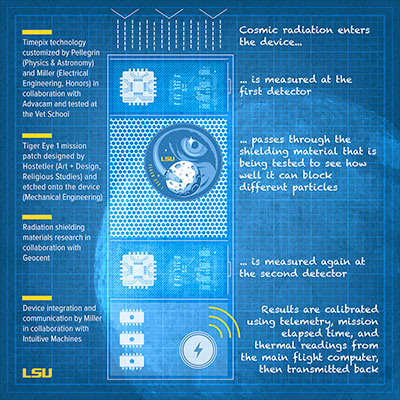 Above: One reason for the "Tiger Eye" name: the detectors in the device are configured like a telescope. The radiation enters the aperture, is measured at the first detector, then travels through the material being tested and is measured again at the second detector. This allows the researchers to understand how effective the material is for shielding the cosmic ray environment. Students in five different LSU colleges and schools are leading the charge under the direction of Assistant Professor Jeffery Chancellor in the LSU Department of Physics & Astronomy, head of its Space Radiation Transport & Applied Nuclear (SpaRTAN) lab. All are undergraduate seniors from Louisiana: Haley Pellegrin, from Bourg in Terrebonne Parish, is a LaSpace Undergraduate Research Fellow and member of the SpaRTAN lab where she develops new technologies to make better radiation shielding (LSU College of Science). Jacob Miller, from Crowley in Acadia Parish, is an electrical engineering major who builds new devices for medical applications (LSU College of Engineering, LSU Honors College). Katie Hostetler, from Zachary in East Baton Rouge Parish, is a graphic designer who creates art for LSU Athletics and this spring came up with the winning design for the Tiger Eye 1 mission patch; she's double-majoring in religious studies (LSU School of Art + Design, LSU College of Humanities & Social Sciences). "We're immensely proud of the LSU students leading this work on the frontier of science, technology, art, and the human imagination," said Samuel J. Bentley, vice president of research and economic development. "It's been incredible to see and support all of LSU coming together to move this mission forward. There should be no barriers to expertise, and this university-industry collaboration is a great example of how the caliber of our students and researchers can advance projects of critical importance to our nation." "This student-led, cross-campus collaboration reinforces LSU's impact on space exploration and planetary science," added Cynthia Peterson, dean of the LSU College of Science. "As we prepare to put people on the Moon again in 2024, we must not only understand what it takes to protect our astronauts, but also what is required to perform science experiments in a space environment and safeguard the technologies needed to conduct the research." Through its medical and health physics program and the SpaRTAN lab, LSU helps agencies and companies understand background radiation in space, one of the hard limits on how much time people and equipment can spend out there, beyond the Earth's protective magnetic field. Understanding the types and amounts of radiation that exist on the Moon will be key to establishing a sustainable human presence on Earth's nearest neighbor as well as traveling to Mars. The data brought back by Tiger Eye 1 will further the SpaRTAN lab's research on improved radiation shielding in both materials and design. "We have models and predictions for human health risk on the Moon, but we don't yet have actual measurements of the radiation spectrum on the lunar surface," Chancellor said. "Now that we'll get real data, we can use it to validate our models, make better predictions, and increase the safety of future space travel." 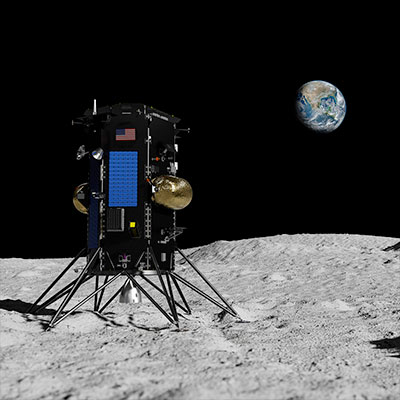 Above: The phone-sized LSU radiation detection device will be mounted on the outside of Intuitive Machines’ Nova-C lunar lander with no mass between itself and the surrounding environment after the lander disconnects from the SpaceX Falcon 9 launch rocket. The IM in IM-1 stands for Intuitive Machines, a Houston-based company pioneering humanity's next step—returning the U.S. to the surface of the Moon. IM holds NASA and commercial payload contracts for two separate lunar landings (IM-1 in the first quarter of 2022 and IM-2 in the fourth quarter) to help pave the way for the Artemis program, which will put the first woman and the first person of color on the Moon as early as 2024. The CLPS flights are all uncrewed and will make use of rovers and robots to conduct science experiments and test technologies in different areas on the lunar surface. Intuitive Machines is providing the vehicle, communication network, and mission operations center for LSU's device to safely land on the Moon and effectively conduct research. IM's Nova-C lunar lander will be launched from a SpaceX Falcon 9 rocket. The solar battery-driven vehicle will spend two weeks on the surface before succumbing to lunar night, not far from Tranquility Base where Neil Armstrong and Buzz Aldrin first walked on the Moon in July 1969 during the Apollo 11 mission. "The two main barriers for human spaceflight are propulsion—how to get there faster—and how to protect humans and equipment from radiation," said retired Colonel Jack "2fish" Fischer, astronaut and vice president of strategic programs at Intuitive Machines. "Without the shielding and radiation modeling LSU is helping to develop, the radiation effects on crews and equipment during deep space exploration would be catastrophic." "Using Jeff Chancellor's ability to model this stuff and figure out what kind of shielding to use and where to put it, we see a future where it will be much easier and cheaper to go into space because we could open the lunar and space economy to a global supply chain," Fischer continued. "We could put commercial, off-the-shelf technology out there and lessen the dependency on expensive, overdesigned solutions. The radiation data we'll get on IM-1 will change the equation of what's possible in space." LSU's Tiger Eye 1 mission was enabled in partnership with Geocent, a New Orleans-based company that provides solutions and talent for the space, defense, and homeland security communities. Geocent chose LSU as a research and development partner to test some of their radiation shielding, which led to an opportunity to share physical space onboard IM-1. "Geocent and our teammates—Plasma Processes, the University of Alabama at Birmingham, and the University of Tennessee, Knoxville—are proud to bring Geocent's ACCRES Radiation Shielding technology to the partnership with LSU and Dr. Jeff Chancellor, Intuitive Machines, and especially LSU students to work on critical research and technologies that truly advance human spaceflight and exploration," said Robert A. "Bobby" Savoie, CEO of Geocent and LSU Engineering alumni. "We're a national company but Louisiana-born, and it's thrilling to see students from several disciplines coming together to make significant contributions to an important mission. Geocent's technical strength is in its people, and we can't imagine a better way to build talent than challenging students to work together and rise to the occasion to put Tiger Eye 1 and their footprint on the Moon." The LSU radiation detection device is currently being customized by Pellegrin and Miller who, as official project manager, also will engage LSU mechanical engineering's advanced manufacturing and machining capabilities to etch Hostetler's Tiger Eye 1 mission patch onto the physical device casing, which will occupy a space about the size of an iPhone 12. "The most challenging thing on missions like these is working within strict limitations on mass, volume, power, bandwidth, and time, as well as communicating with and controlling devices from Earth, which means solving problems no one's solved before," Pellegrin said. "I'm super excited to be part of this mission and the knowledge and skills I've gained have already kickstarted my career. They helped me land an internship at Geocent, which is a dream come true since I want to work in space and missile systems development." Pellegrin and Miller are also working with Advacam, a company based in the Czech Republic, on adapting radiation detection hardware (similar to a USB flash drive) that it has previously supplied for the International Space Station (ISS). But while you can bring laptops and off-the-shelf equipment to ISS to help integrate and connect such devices, that isn't possible on IM-1. Much of Miller's work on Tiger Eye 1 lies in software development and coding (and possibly some wiring and soldering) to make sure the data from the sensor "makes sense" to the device, which must be able to communicate with the main Intuitive Machines flight computer to receive time stamps, temperature readings, and other critical data. The LSU team is setting up a Tiger Eye 1 ground control center right on the main campus and hopes to be able to receive raw data as well as issue commands to the device while it is traveling through space and on the lunar surface. "It's sort of an engineering and computer science joke, but the amount of problems we solve by turning a device off and back on again is kind of astounding," Miller said. "So, if we stop being able to communicate with the device or get weird readings, we need to be able to tell the lander to perform a power cycle to reboot our device or change other settings. Rather than just seeing a problem, we need to be able to do something about it without physically touching the device." Earlier this year, Pellegin walked the Timepix chip the team will be using as a sensor over to the LSU School of Veterinary Medicine's linear accelerator (where radiation is used to help treat animals with cancer) for initial testing. "Most of our patients are dogs and cats, but we do treat the occasional reptile, rabbit, horse, or other pet," said Jayme Looper, director of the LSU Small Animal Hospital and its radiation oncology services. "Our recent collaboration with the LSU medical physics team to test the radiation detection device prior to its journey to the Moon is an example of a long history of intercollegiate collaboration at LSU." Chancellor did the initial characterization of the Timepix technology in the 1990s as a master's student under advisor Larry Pinsky at the University of Houston, who did the dosimetry for the Apollo mission. "It takes a lot of time to sort of gather all of the information about how everything communicates and the protocols everybody's following," Miller added. "It gets complicated really fast. But as an engineering student, I like the challenge of doing something that's really, truly new in just a few months. It's as scary as it's appealing, and the result is going to benefit human spaceflight for years to come." |
Robert Pearlman
Editor Posts: 51987
From: Houston, TX
Registered: Nov 1999
|
 posted 02-06-2023 12:00 PM
posted 02-06-2023 12:00 PM
   
NASA release NASA Redirects Intuitive Machines' First Mission to the Lunar South Pole RegionIntuitive Machines is collaborating with NASA to prioritize the return of lunar scientific data in support of the Artemis Program. As part of this joint effort, Intuitive Machines will shift the landing site of its first mission to the lunar South Pole Region in support of NASA's priority objectives. "Redirecting Intuitive Machines' IM-1 mission landing site is a testament to our collective commitment to supporting NASA's Artemis Program and advancing lunar exploration for the benefit of humanity," said Steve Altemus, co-founder, president and CEO of Intuitive Machines. "The company is honored to accept the historic and scientific responsibility of bringing the United States to the lunar South Pole Region for the first time ever." Intuitive Machines is working closely with its stakeholders to ensure a seamless landing site change. The landing date is currently scheduled for late June of 2023. This change is expected to positively impact Intuitive Machines' backlog. More importantly, Intuitive Machines views this as a significant win for the Artemis Program. NASA has its sights set on locations around the South Pole Region for the Artemis era of human lunar exploration. The agency has identified the South Pole Region as one with characteristics that hold promise for unprecedented deep-space scientific discoveries, like discovering water ice on the Moon. Intuitive Machines' Nova-C lunar lander would become the first spacecraft to land on the Moon's South Pole Region. |
Robert Pearlman
Editor Posts: 51987
From: Houston, TX
Registered: Nov 1999
|
 posted 05-25-2023 08:05 PM
posted 05-25-2023 08:05 PM
   
NASA release Intuitive Machines Lunar Landing Site Moves to South PoleNASA, in cooperation with Intuitive Machines, is moving the landing site for the first Commercial Lunar Payload Services (CLPS) mission to Moon's South Pole as an important first step in managing risks for future Artemis landings. 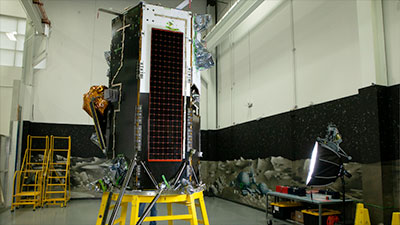 Above: Intuitive Machines' Nova-C lunar lander inside the company's facility at the Houston Spaceport. (Intuitive Machines) One of the first lunar payload deliveries under NASA's CLPS initiative was awarded to Intuitive Machines in May 2019. The company's first flight, Intuitive Machines-1 (IM-1) will carry six NASA payloads on its Nova-C lunar lander to a site near the Malapert A crater. This relatively flat and safe region is within the heavily cratered southern highlands on the side of the Moon visible from Earth. The NASA payloads will focus on demonstrating communication, navigation and precision landing technologies, and gathering scientific data about rocket plume and lunar surface interactions, as well as space weather and lunar surface interactions affecting radio astronomy. Through the CLPS initiative, NASA is supporting the development of a lunar economy by working with American companies to deliver scientific, exploration, and technology payloads to the Moon's surface and lunar orbit. 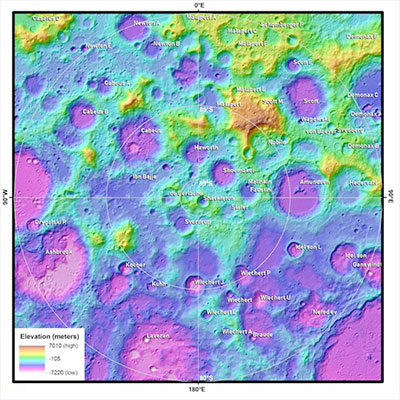 Above: The Malapert A region is seen near the top of this topographic map of the Moon's South Pole based on data released by the Lunar Reconnaissance Orbiter Lunar Orbiter Laser Altimeter. (Lunar and Planetary Institute Regional Planetary Image Facility) The decision to move from the original landing site in Oceanus Procellarum was based on a need to learn more about terrain and communications near the lunar South Pole, which is expected to be one of the best locations for a sustained human presence on the Moon. Landing near Malapert A also will help mission planners understand how to communicate and send data back to Earth from a location that is low on the lunar horizon. The landing date is expected in the third quarter of 2023. While NASA is the primary customer purchasing lunar delivery services, CLPS vendors also work with other customers to send non-NASA payloads to the Moon. CLPS providers are responsible for managing their activities to ensure they are compliant with NASA schedule requirements. Intuitive Machines will confirm the launch date, lunar landing date, and duration of lunar surface operations, as well as updates on the thermal environment that the payloads will experience, given the temperature extremes for lunar transit and at the lunar South Pole. |
Robert Pearlman
Editor Posts: 51987
From: Houston, TX
Registered: Nov 1999
|
 posted 08-14-2023 06:26 PM
posted 08-14-2023 06:26 PM
   
Intuitive Machines is expecting to launch IM-1 in November. Intuitive Machines CEO Steve Altemus said, "During the second quarter, we were laser-focused on the final assembly process in preparing IM-1 for launch. Our lunar lander is complete and will be prepared for delivery in September. The company has secured a launch window from pad 39A, preserving a six-day launch window starting on November 15th." |
Robert Pearlman
Editor Posts: 51987
From: Houston, TX
Registered: Nov 1999
|
 posted 10-03-2023 01:37 PM
posted 10-03-2023 01:37 PM
   
collectSPACE Up close with Intuitive Machine's Nova-C lunar lander before it leaves for the moonThe first lunar lander to be built in Houston is ready to leave Space City for the moon. Intuitive Machines on Tuesday (Oct. 2) provided a last close-up look at its Nova-C robotic lander before packing it up to move to Florida in preparation for its launch. The spacecraft may become the first U.S.-built vehicle to achieve a soft landing on the moon since NASA's Apollo 17 astronauts touched down in December 1972. 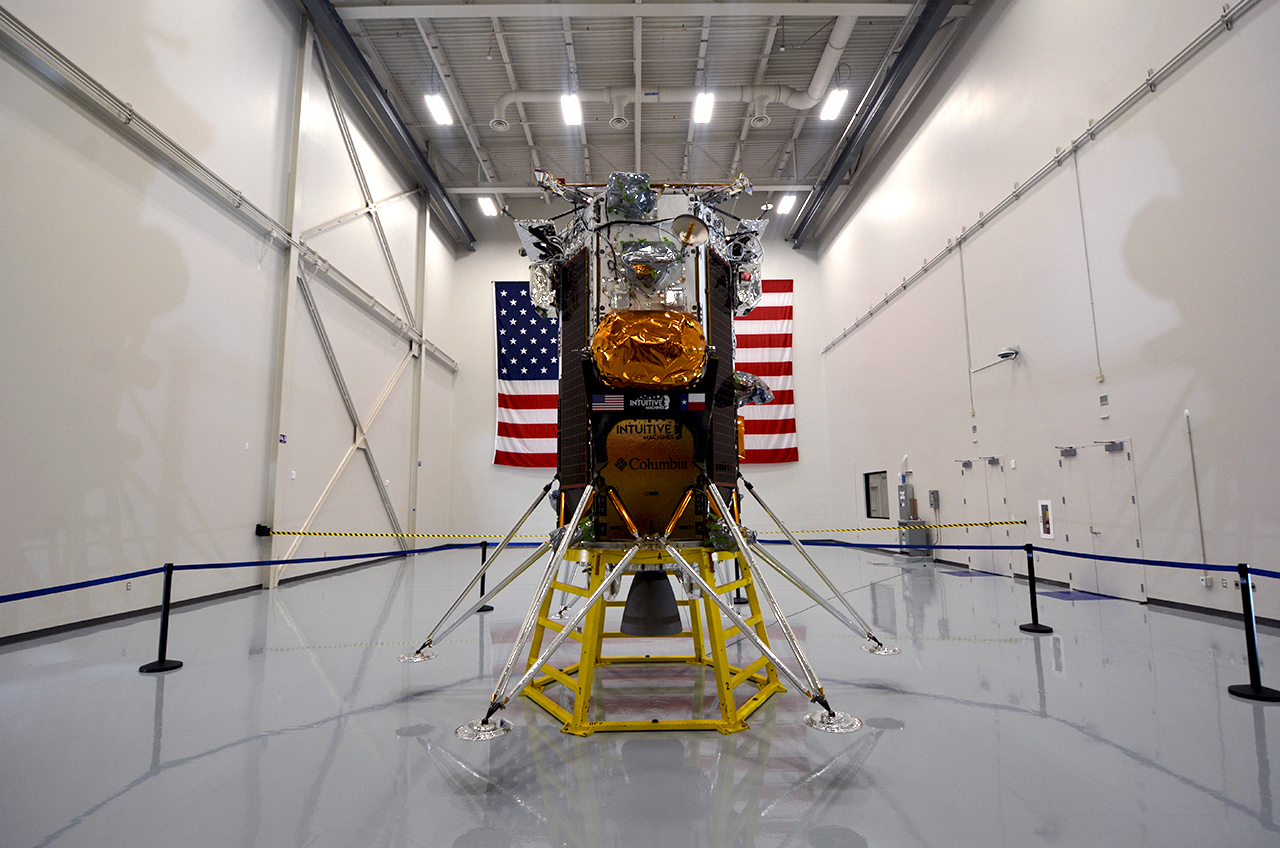 |
Robert Pearlman
Editor Posts: 51987
From: Houston, TX
Registered: Nov 1999
|
 posted 10-27-2023 04:12 PM
posted 10-27-2023 04:12 PM
   
Intuitive Machines release Intuitive Machines Sets January 2024 For Historic U.S. Lunar MissionIntuitive Machines has announced that in coordination with SpaceX, liftoff of the IM-1 lunar mission is now targeted for a multi-day launch window which opens January 12, 2024. "As previously announced, Intuitive Machines completed its lunar lander in September, and the entire company is looking forward to our upcoming launch," said Steve Altemus, Co-Founder, President, and Chief Executive Officer. "There are inherent challenges of lunar missions; schedule changes and mission adjustments are a natural consequence of pioneering lunar exploration. Receiving a launch window and the required approvals to fly is a remarkable achievement, and the schedule adjustment is a small price to pay for making history." The Intuitive Machines IM-1 mission will be the Company's first attempted lunar landing as part of NASA's Commercial Lunar Payload Services ("CLPS") initiative, a key part of NASA's Artemis lunar exploration efforts. The science and technology payloads sent to the Moon's surface as part of CLPS intend to lay the foundation for human missions and a sustainable human presence on the lunar surface. In case of unfavorable launch conditions, such as poor weather, backup opportunities will be determined based on the lunar blackout window and other factors. |
Robert Pearlman
Editor Posts: 51987
From: Houston, TX
Registered: Nov 1999
|
 posted 12-04-2023 09:14 AM
posted 12-04-2023 09:14 AM
   
Intuitive Machines release Intuitive Machines Nova-C Lunar Lander Arrives in Cape Canaveral, FloridaIntuitive Machines, Inc. has announced the successful delivery of its IM-1 mission Nova-C lunar lander to Cape Canaveral, Florida. 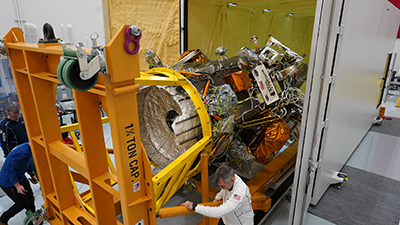 Above: Intuitive Machines engineers loading the IM-1 mission Nova-C lunar lander into its custom container in Houston, TX. "Reaching this tremendous milestone has built a four-year foundation of technical excellence earned through challenges, failures, and triumph; I'm so proud of this team leading the United States back to the Moon," said Intuitive Machines CEO Steve Altemus. "The opportunity to deliver the first of three manifested lunar landers with NASA and commercial payloads is an incredible moment for the entire commercial aerospace industry, and I'm looking forward to this launch as well as our subsequent missions in the near future." In coordination with SpaceX, the liftoff of the IM-1 lunar mission is targeted for a multi-day launch window that opens no earlier than January 12, 2024. In case of unfavorable launch conditions, such as poor weather, backup opportunities will be determined based on the lunar blackout window and other factors. The Company's IM-1 mission will be operated from Intuitive Machines' Nova Control Center in Houston, Texas. There, flight controllers will monitor spacecraft health, send commands, and receive data during the lander's approximate six-and-a-half-day journey to the lunar surface using the Company's commercially available Lunar Data Network. After landing, Intuitive Machines and its customers expect Nova-C to operate in the lunar south pole region for nearly two weeks. As previously announced, Intuitive Machines completed the IM-1 lunar lander in September at the Company's Lunar Production and Operations Center located at the Houston Spaceport. In late November, the lander was loaded into a custom-designed air ride ground transport system and delivered to Cape Canaveral, Florida. IM-1 will be the Company's first of three manifested attempted lunar landings as part of NASA's Commercial Lunar Payload Services ("CLPS") initiative, a key part of NASA's Artemis lunar exploration efforts. The science and technology payloads sent to the Moon's surface as part of CLPS intend to lay the foundation for a sustainable human presence on the lunar surface and the commercial development of the Moon. |
Robert Pearlman
Editor Posts: 51987
From: Houston, TX
Registered: Nov 1999
|
 posted 12-19-2023 04:03 PM
posted 12-19-2023 04:03 PM
   
Intuitive Machines release Intuitive Machines IM-1 Lunar Mission Launch UpdateIntuitive Machines announced in coordination with SpaceX, launch of the Company's IM-1 lunar mission is now targeted for a multi-day launch window that opens no earlier than mid-February 2024. The updated window comes after unfavorable weather conditions resulted in shifts in the SpaceX launch manifest. The mid-February launch window is the next available opportunity to launch IM-1 given the monthly lunar blackout period; the IM-1 mission Nova-C lunar lander is targeted to land near the south pole of the Moon, requiring specific lighting conditions that are only available for a handful of days each month. The Company's IM-1 mission Nova-C lunar lander remains ready. As previously announced, Intuitive Machines delivered its IM-1 mission Nova-C lunar lander to Cape Canaveral, Florida, earlier this month. Since arriving in Florida, the IM-1 lunar lander has completed major system tests, verification, and certification milestones and is prepared for integration with SpaceX's Falcon 9 rocket. |
Robert Pearlman
Editor Posts: 51987
From: Houston, TX
Registered: Nov 1999
|
 posted 02-05-2024 05:30 PM
posted 02-05-2024 05:30 PM
   
Intuitive Machines release Intuitive Machines Lunar Lander Encapsulated and Scheduled for LaunchIntuitive Machines announced its IM-1 mission Nova-C class lunar lander completed all integration milestones and is safely encapsulated within SpaceX's payload fairing in preparation for launch. 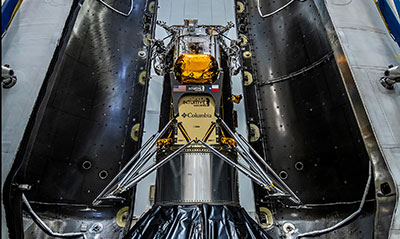 In coordination with SpaceX, launch of the Company's IM-1 mission is targeted for a multi-day launch window that opens no earlier than 12:57 a.m. Eastern Standard Time on Feb. 14 from Launch Complex 39A at NASA's Kennedy Space Center in Florida. "As we prepare to embark on our IM-1 mission to the Moon, we carry with us the collective spirit of perseverance, fueled by the dedication and hard work of everyone on our team," said Intuitive Machines President and CEO Steve Altemus. "Their tireless efforts have brought us to this moment, where we stand on the precipice of history, humbled by the gravity of our mission, yet emboldened by the boundless possibilities that lie ahead." The Intuitive Machines IM-1 mission will be the Company's first attempted lunar landing as part of NASA's Commercial Lunar Payload Services ("CLPS") initiative, a key part of NASA's Artemis lunar exploration efforts. The science and technology payloads sent to the Moon's surface as part of CLPS intend to lay the foundation for human missions and a sustainable human presence on the lunar surface. 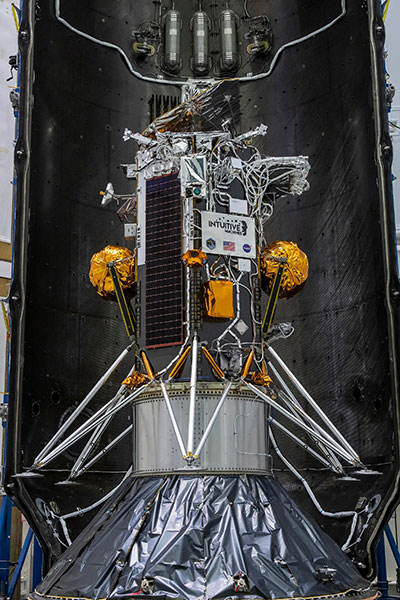 |
Robert Pearlman
Editor Posts: 51987
From: Houston, TX
Registered: Nov 1999
|
 posted 02-13-2024 11:05 AM
posted 02-13-2024 11:05 AM
   
Intuitive Machines release Intuitive Machines and SpaceX Complete Successful IM-1 Test CampaignIntuitive Machines and SpaceX have analyzed the data from the lunar lander fueling tests for the IM-1 mission and determined the testing campaign is complete. Liftoff of the IM-1 mission is targeted for a multi-day launch window that opens at 12:57 a.m. Eastern Standard Time on February 14, 2024, from Launch Complex 39A at NASA's Kennedy Space Center in Florida. 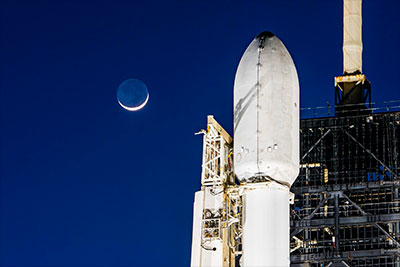 |
Robert Pearlman
Editor Posts: 51987
From: Houston, TX
Registered: Nov 1999
|
 posted 02-15-2024 12:30 AM
posted 02-15-2024 12:30 AM
   
collectSPACE Odysseus' odyssey: Intuitive Machines IM-1 Nova-C lander launches to the moonHouston, Texas has long taken pride in its name being the first word addressed back to Earth by the first humans to land on the moon. Now, more than 50 years later, the first spacecraft built entirely in Houston is on its way to becoming the first commercial lander to touch down on the lunar surface. Intuitive Machines' IM-1 Nova-C moon lander is not carrying a crew so will not be able to call back, "Houston, Odysseus has landed" as the Apollo 11 astronauts on Eagle did in 1969, but if successful, the robotic spacecraft's achievement should be heard in "Space City" and around the world. It will mark the return of the United States to the lunar surface as NASA works to resume landing astronauts under its Artemis program. 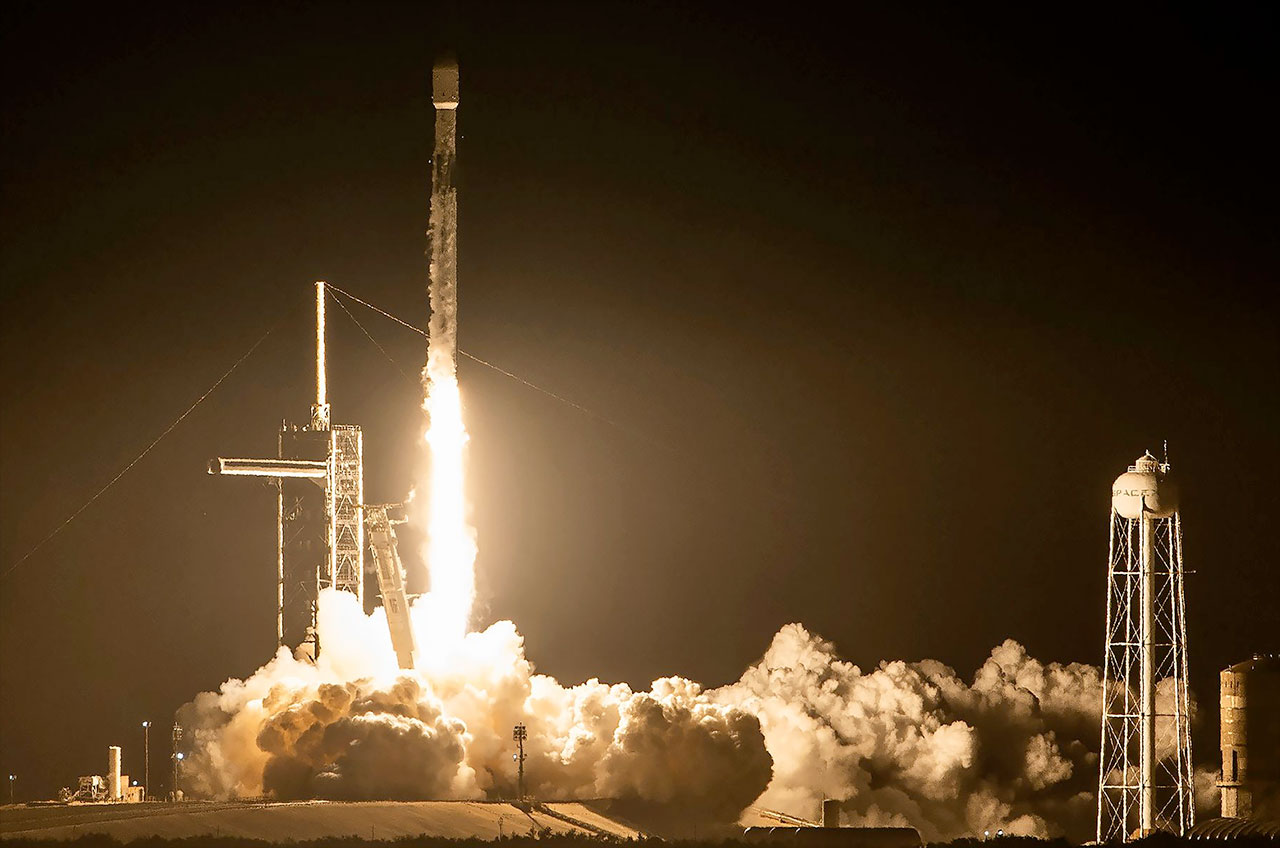 |
Robert Pearlman
Editor Posts: 51987
From: Houston, TX
Registered: Nov 1999
|
 posted 02-15-2024 07:04 PM
posted 02-15-2024 07:04 PM
   
Intuitive Machines update IM-1 Mission Vehicle Health UpdateThe IM-1 mission Nova-C class lunar lander continues to be in excellent health, and we are preparing for our engine commissioning maneuver. Following nominal launch vehicle separation, the spacecraft autonomously brought up all sensors and radios. Odysseus listened to the Inertial Measurement Unit to determine attitude rates and activated the Reaction Control System to nullify those attitude rates as designed. Earlier today, Nova-C's navigation system rejected star tracker data, but a patch has been sent to the spacecraft, and the star tracker updates have resumed nominal operations. Initially, the star tracker information was numerically conditioned slightly differently than we anticipated. We were expecting a one-in-a-thousand numerical tolerance and received a number more like two and three in a thousand. So, Nova-C's navigation system rejected the star tracker data. When we tested this system terrestrially, they were within tolerance, but we experienced slightly different numerical conditioning in flight. The vehicle had a very low rate of rotation, approximately .15 degrees per second, mostly around the long axis, which caused our solar arrays and antennas to rotate in and out of the desired attitude. We noticed that, at one point, we passed through Nova-C's max power attitude, and we recorded the artificial attitude. We then manually forced the navigation system to advance to attitude pointing and commanded the vehicle to go to the maximum power attitude we observed. This put Nova-C into a power-positive configuration and fully charged Nova-C's batteries. With the diagnostic data we collected, we identified a patch to align the numerical conditioning of the star tracker data with our navigation system's acceptance test. We tested the patch on the ground, sent it to the spacecraft, restarted the star tracker, and immediately began processing star tracker updates – resuming nominal operations. Again, the IM-1 mission Nova-C class lunar lander is in excellent health, and we are preparing for Odysseus' commissioning maneuver. |
Robert Pearlman
Editor Posts: 51987
From: Houston, TX
Registered: Nov 1999
|
 posted 02-16-2024 02:47 PM
posted 02-16-2024 02:47 PM
   
Intuitive Machines update IM-1 Mission Engine Commissioning UpdateThe IM-1 mission Nova-C class lunar lander continues to be in excellent health, in a stable orientation and remains on schedule for a lunar landing opportunity on the afternoon of February 22. The original mission structure allocated a Commission Maneuver (CM) and three trajectory correction maneuvers to position for Lunar Orbit Insertion. This approach provided flexibility in the mission's engine burn schedule to allow for learning as we operate the lander in the vacuum of space. Adjusting for this learning process is why the team chose to delay the burn on February 15. Communication delays and outages are expected when executing lunar missions, which we accounted for in our mission planning. While preparing for the CM burn last night, flight controllers experienced intermittent uplink and downlink data communications between Nova-C and the ground stations, potentially impacting our ability to collect the critical information required to support the CM burn and follow-on performance analysis. As we prepared for the first-ever in-space ignition of a liquid methane and liquid oxygen engine, we reviewed our Earth-based test data against the data we've accumulated in space. The in-space performance demonstrated that it takes longer to chill the liquid oxygen feed line than the Earth-based testing. After understanding the in-space liquid oxygen feedline requirements, we adjusted and uploaded the CM burn preparation timeline and increased the onboard event sequence timer. Again, the IM-1 mission Nova-C class lunar lander is in excellent health, and we expect to continue to provide mission updates at least once a day. |
Robert Pearlman
Editor Posts: 51987
From: Houston, TX
Registered: Nov 1999
|
 posted 02-17-2024 09:45 AM
posted 02-17-2024 09:45 AM
   
Intuitive Machines update IM-1 Mission Engine Commissioning UpdateIntuitive Machines flight controllers successfully fired the first liquid methane and liquid oxygen engine in space, completing the IM-1 mission engine commissioning. This engine firing included a full thrust mainstage engine burn and throttle down-profile necessary to land on the Moon. Over the next eight hours, flight controllers will analyze the engine burn data collected from over 270,000 km away from Earth. This represents another first for Intuitive Machines, demonstrating one of the critical technologies required to land softly on the surface of the Moon. The IM-1 mission Nova-C class lunar lander continues to be in excellent health, in a stable orientation and remains on schedule for a lunar landing opportunity on the afternoon of February 22. |
Robert Pearlman
Editor Posts: 51987
From: Houston, TX
Registered: Nov 1999
|
 posted 02-18-2024 07:56 PM
posted 02-18-2024 07:56 PM
   
Intuitive Machines update IM-1 Mission Maneuvers and Events UpdateOdysseus continues to be in excellent health, and flight controllers are preparing planned trajectory correction maneuvers to prepare the lander for lunar orbit insertion. Since the IM-1 Mission launched on SpaceX's Falcon 9 rocket, flight controllers on the Company's red, white, and blue teams have been learning more about the lander and how to efficiently fly the mission to return the United States to the surface of the Moon. February 17th, Intuitive Machines published the first IM-1 Mission images, capturing Earth in the background as Odysseus drifted away toward the Moon. Payload Integration Managers programmed the lander's wide and narrow field of view cameras to take five quick images every five minutes for two hours, starting 100 seconds after separating from SpaceX's second stage. Out of all the images collected, Intuitive Machines chose to show humanity's place in the universe with four wonderful images we hope to inspire the next generation of risk-takers. Looking forward, Intuitive Machines expects to execute lunar orbit insertion on February 21st, with a lunar landing opportunity on the afternoon of the 22nd. We intend to stream the landing on the Intuitive Machines IM-1 Mission web page and announce the exact landing time tomorrow as Columbia Sportswear takes over the exterior of Sphere in Las Vegas, showcasing the role Omni-Heat Infinity technology is playing in the IM-1 Mission. Again, Odysseus continues to be in excellent health, and flight controllers are preparing planned trajectory correction maneuvers to prepare the lander for lunar orbit insertion. We expect to continue to provide mission updates at least once a day on X and the IM-1 Mission webpage. |
Robert Pearlman
Editor Posts: 51987
From: Houston, TX
Registered: Nov 1999
|
 posted 02-19-2024 06:30 PM
posted 02-19-2024 06:30 PM
   
Intuitive Machines update IM-1 Engine Maneuvers UpdateFlight controllers received and analyzed data from the February 16th engine Commissioning Maneuver (CM). Data from the 21-second full-thrust mainstage engine CM confirmed Odysseus hit its 21 m/s target with approximately 0.8 m/s accuracy. Propulsion mixture ratios, mass flow rate, and temperature were as predicted. Overall, Intuitive Machines characterizes the execution of the CM as nominal and per expectations. On February 18th, flight controllers commanded the lander's first planned trajectory correction maneuver, igniting the lander's engine for the second time, and are planning the anticipated final required maneuver before Odysseus' largest challenge to date, lunar orbit insertion, which is expected on Wednesday, February 21st. In addition, flight controllers completed all NASA and commercial transit payload operations this morning. Odysseus continues to be in excellent health, and flight controllers are analyzing and managing the lander's thermal conditioning for critical systems and payloads with a combination of heater power and attitude control to maximize efficiency. We expect to continue to provide mission updates at least once a day, leading up to a live stream for landing coverage. |
Robert Pearlman
Editor Posts: 51987
From: Houston, TX
Registered: Nov 1999
|
 posted 02-19-2024 09:51 PM
posted 02-19-2024 09:51 PM
   
Intuitive Machines update IM-1 Landing TimeThe IM-1 mission to land on the Moon has triumphed over numerous challenges, showcasing exceptional resilience, innovation, and teamwork. Intuitive Machines expects to land on the Moon at 1649 CST on Thursday, February 22nd. |
Robert Pearlman
Editor Posts: 51987
From: Houston, TX
Registered: Nov 1999
|
 posted 02-20-2024 04:50 PM
posted 02-20-2024 04:50 PM
   
Intuitive Machines update Planned Trajectory Correction Maneuvers Complete Ahead of Lunar Orbit InsertionIntuitive Machines flight controllers commanded the IM-1 mission's second planned Trajectory Correction Maneuver (TCM) with enough precision to eliminate the need for the initially planned third TCM engine firing. Today's TCM fired at 1400 CST for 8 seconds, and it is the final maneuver before Odysseus' largest challenge to date, Lunar Orbit Insertion (LOI), scheduled for February 21, 2024. Odysseus continues to be in excellent health and is approximately 68,000 km from the Moon. Over the next several hours, flight controllers will continue to analyze the flight data ahead of LOI. |
Robert Pearlman
Editor Posts: 51987
From: Houston, TX
Registered: Nov 1999
|
 posted 02-21-2024 09:26 AM
posted 02-21-2024 09:26 AM
   
Intuitive Machines release IM-1 Mission Completes Lunar Orbit Insertion and Enters Lunar OrbitOdysseus completed its scheduled 408-second main engine lunar orbit insertion burn and is currently in a 92 km circular lunar orbit. Initial data indicates the 800 m/s burn was completed within 2 m/s accuracy. After traveling over 1,000,000 km, Odysseus is now closer to the Moon than the end-to-end distance driving across Space City, Houston, TX. Over the next day, while the lander remains in lunar orbit, flight controllers will analyze the complete flight data and transmit imagery of the Moon. |
Robert Pearlman
Editor Posts: 51987
From: Houston, TX
Registered: Nov 1999
|
 posted 02-21-2024 05:27 PM
posted 02-21-2024 05:27 PM
   
Intuitive Machines update Landing Trajectory UpdateFlight controllers analyzed the post-Lunar Orbit Insertion engine burn data and updated the anticipated flight maneuver timing, including an expected 1630 CST landing opportunity. The landing opportunity will be Odysseus’ hardest challenge yet. The lander continues to be in excellent health, orbiting approximately 92 km above the lunar surface. |
Robert Pearlman
Editor Posts: 51987
From: Houston, TX
Registered: Nov 1999
|
 posted 02-22-2024 09:48 AM
posted 02-22-2024 09:48 AM
   
Intuitive Machines update Terrain Relative Navigation ImageOdysseus' Terrain Relative Navigation camera captured this image of the Bel'kovich K crater in the Moon's northern equatorial highlands. It is an approximate 50 km diameter crater with mountains in the center, made when the crater was formed. 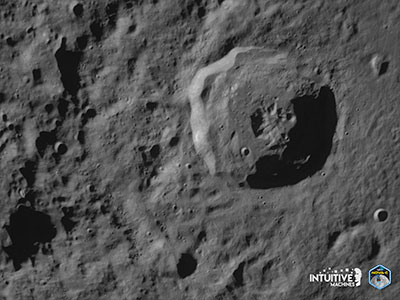 |
Robert Pearlman
Editor Posts: 51987
From: Houston, TX
Registered: Nov 1999
|
 posted 02-22-2024 10:53 AM
posted 02-22-2024 10:53 AM
   
Intuitive Machines update IM-1 Landing TimeFlight controllers commanded a lunar correction maneuver to raise Odysseus' orbit overnight and updated the anticipated landing time to 1524 CST (2124 GMT). |
Robert Pearlman
Editor Posts: 51987
From: Houston, TX
Registered: Nov 1999
|
 posted 02-22-2024 01:40 PM
posted 02-22-2024 01:40 PM
   
Intuitive Machines update IM-1 Landing TimeFlight controllers chose to exercise an additional orbit before starting the IM-1 Mission landing sequence. The new anticipated landing time is 1724 CST (2324 GMT). |
Robert Pearlman
Editor Posts: 51987
From: Houston, TX
Registered: Nov 1999
|
 posted 02-22-2024 06:00 PM
posted 02-22-2024 06:00 PM
   
collectSPACE Intuitive Machines' Odysseus achieves first US moon landing since ApolloThe United States is back on the moon for the first time since the Apollo astronauts set foot there more than 50 years ago. What's more, the vehicle that achieved the feat is now the world's first commercial spacecraft to land on a celestial body other than Earth. "Odysseus," Intuitive Machines' first Nova-C lander, touched down on Thursday (Feb. 22), seven days after launching from Earth. The six-legged robotic probe landed at 6:24 p.m. EST (2324 GMT) in the vicinity of Malapert A, a 43-mile-wide (69-km) crater located about 186 miles (300 km) from the moon's south pole. 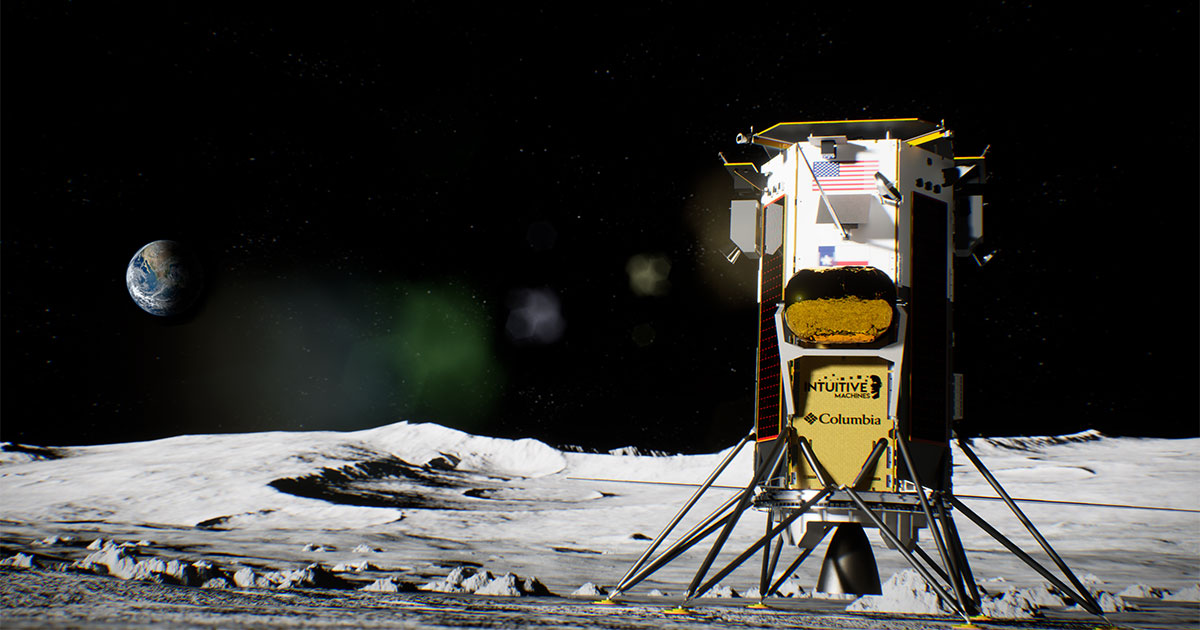 |
Robert Pearlman
Editor Posts: 51987
From: Houston, TX
Registered: Nov 1999
|
 posted 02-23-2024 08:33 AM
posted 02-23-2024 08:33 AM
   
Intuitive Machines update Lunar Surface Day OneOdysseus is alive and well. Flight controllers are communicating and commanding the vehicle to download science data. The lander has good telemetry and solar charging. We continue to learn more about the vehicle's specific information (latitude/longitude), overall health, and attitude (orientation). |
Robert Pearlman
Editor Posts: 51987
From: Houston, TX
Registered: Nov 1999
|
 posted 02-23-2024 03:15 PM
posted 02-23-2024 03:15 PM
   
Embry-Riddle University release EagleCam Update: Camera System Deployment ForthcomingDue to complications with Odysseus’ internal navigation system — specifically concerning the software patch to navigation data to include NASA’s NDL (Navigation Doppler Lidar) payload, which is meant to ensure a soft landing — the decision was made to power down EagleCam during landing and not deploy the device during Odysseus’ final descent. However, both the Intuitive Machines and EagleCam teams still plan to deploy EagleCam and capture images of the lander on the lunar surface as the mission continues. The time of deployment is currently unknown. Stay tuned! More information will be released as soon as it becomes available. |
Robert Pearlman
Editor Posts: 51987
From: Houston, TX
Registered: Nov 1999
|
 posted 02-26-2024 08:09 AM
posted 02-26-2024 08:09 AM
   
Intuitive Machines update Odysseus Establishes Southernmost Landing Site, Maintains Communication with Earth, and Sends Additional ImagesOdysseus continues to communicate with flight controllers in Nova Control from the lunar surface. After understanding the end-to-end communication requirements, Odysseus sent images from the lunar surface of its vertical descent to its Malapert A landing site, representing the furthest south any vehicle has been able to land on the Moon and establish communication with ground controllers. 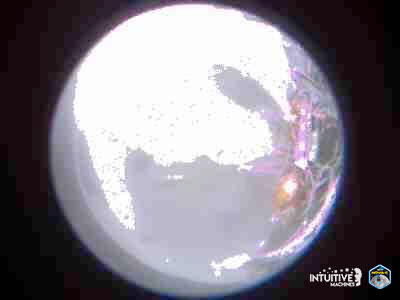 As part of Odysseus' descent onto the lunar surface, Intuitive Machines Hazard Relative Navigation algorithms detected nine safe landing sites within the targeted south pole region, which is an area that contains permanently shadowed regions that may be rich in resources, including water ice that could be used for future propulsion and life support on the Moon. 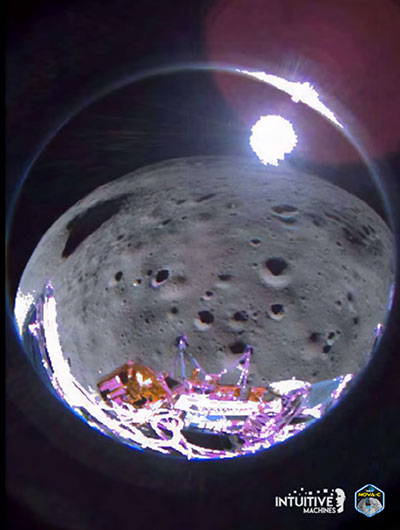 Above: Odysseus captured this image approximately 35 seconds after pitching over during its approach to the landing site. The camera is on the starboard aft-side of the lander in this phase. Images from NASA's Lunar Reconnaissance Orbiter Camera team confirmed Odysseus completed its landing at 80.13 degrees S and 1.44 degrees E at a 2579 m elevation. After traveling more than 600,000 miles, Odysseus landed within 1.5 km of its intended Malapert A landing site, using a contingent laser range-finding system patched hours before landing. 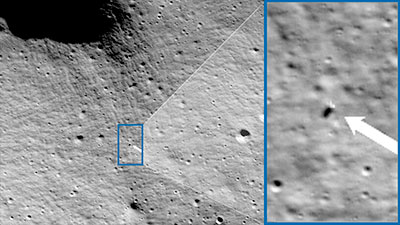 Flight controllers intend to collect data until the lander's solar panels are no longer exposed to light. Based on Earth and Moon positioning, we believe flight controllers will continue to communicate with Odysseus until Tuesday morning. |
Robert Pearlman
Editor Posts: 51987
From: Houston, TX
Registered: Nov 1999
|
 posted 02-27-2024 11:32 AM
posted 02-27-2024 11:32 AM
   
Intuitive Machines update Lunar Surface Day FiveFlight Controllers continue to communicate with Odysseus. This morning, Odysseus efficiently sent payload science data and imagery in furtherance of the Company's mission objectives. Flight controllers are working on final determination of battery life on the lander, which may continue up to an additional 10-20 hours. The images included here are the closest observations of any spaceflight mission to the south pole region of the Moon. Odysseus is quite the photographer, capturing this image approximately 30 meters above the lunar surface while his main engine throttled down more than 24,000 mph. Another day of exploration on the south pole region of the Moon. 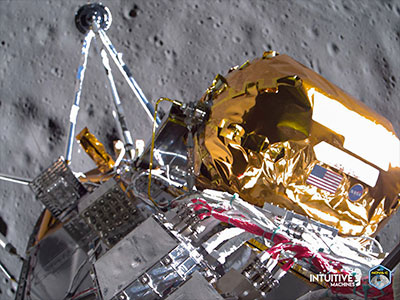 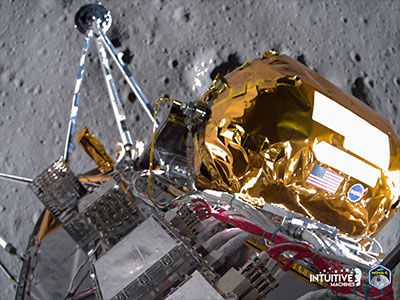
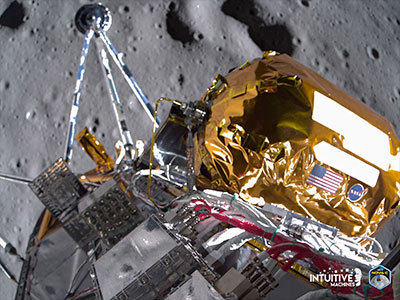
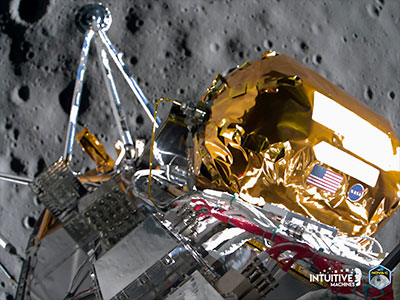
|
Robert Pearlman
Editor Posts: 51987
From: Houston, TX
Registered: Nov 1999
|
 posted 02-28-2024 01:36 PM
posted 02-28-2024 01:36 PM
   
Intuitive Machines photo release Landing imagesThe IM-1 Mission successfully landed the first spacecraft on the Moon's south pole region, marking the United States' first return since Apollo 17 and the first commercial lunar landing to transmit valuable science data of each NASA payload from the lunar surface. In addition, the operation of the Company's liquid methane and liquid oxygen propulsion system in deep space is flight-proven through successful mission operations. Intuitive Machines achieved these marquee accomplishments in the company's first attempt to land on the Moon. The photos included provide some of the first photos of Odyssesus landing on the moon. This image retrieved from the lander on February 27 captures Odysseus' landing strut during landing on February 22nd performing its primary task, absorbing first contact with the lunar surface. Meanwhile, the lander's liquid methane and liquid oxygen engine is still throttling, which provided stability. The Company believes the two insights captured in this image enabled Odysseus to gently lean into the lunar surface, preserving the ability to return scientific data. 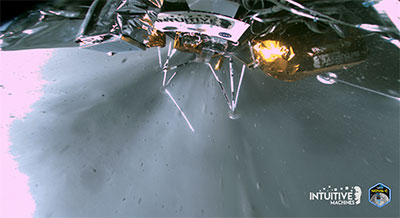 Taken on February 27th, flight controllers commanded Odysseus to capture a new image using its narrow-field-of-view camera. Previous attempts to send photos from landing and the days following returned unusable imagery. After successfully transmitting the image to Earth, flight controllers received additional insight into Odysseus' position on the lunar surface. 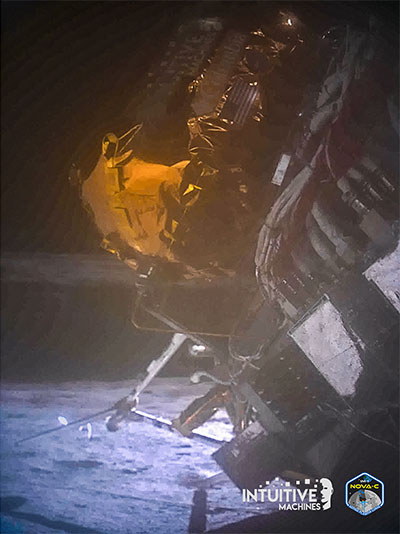 |
Robert Pearlman
Editor Posts: 51987
From: Houston, TX
Registered: Nov 1999
|
 posted 02-29-2024 01:31 PM
posted 02-29-2024 01:31 PM
   
Intuitive Machines update Lunar Surface Day SevenStill kicking. Odysseus continues to operate on the lunar surface. At approximately 11:00 am CST, flight controllers intend to downlink additional data, and command Odie into a configuration that he may phone home if and when he wakes up when the sun rises again. |
Robert Pearlman
Editor Posts: 51987
From: Houston, TX
Registered: Nov 1999
|
 posted 02-29-2024 05:25 PM
posted 02-29-2024 05:25 PM
   
Intuitive Machines release Intuitive Machines Historic IM-1 Mission Success: American Ingenuity Never Gives UpIntuitive Machines today (Feb. 29) announced the completion of science and data transmission for all NASA and commercial payloads onboard Odysseus, the Nova-C class lunar lander, after the successful February 22 soft landing on the south pole region of the Moon. Intuitive Machines CEO Steve Altemus said, "Spaceflight's unique challenges are conquered on Earth but mastered in space. Our now proven robust lunar program, a national asset, feeds directly into our second and third missions. This success drives our relentless pursuit of performance excellence to benefit the entire industry." Intuitive Machines achieved these marquee accomplishments in the Company's first attempt to land on the Moon: - Successfully soft-landed the Company's Nova-C class lunar lander, Odysseus, on the Moon, marking the United States' first lunar landing in over 50 years since Apollo 17
- Validated the performance of the Company's proprietary liquid methane and liquid oxygen propulsion system through the first-ever deep space ignition, followed by multiple restarts, repeatedly providing successful spacecraft maneuvers
- Became the first commercial-sector company and NASA CLPS (Commercial Lunar Payload Services) provider to successfully land and transmit scientific data to and from the Moon
- Landed Odysseus, farther south than any vehicle in the world has ever soft-landed on the Moon, which we believe is significant given NASA's $93B Artemis Campaign is targeting the region for human missions
- Traveled over 600,000 miles and softly landed less than one mile from its intended Malapert A landing region
- Transmitted over 350 megabytes of science and engineering data, which was collected across all payloads; NASA confirms mission success
- Exceeded one of the mission objectives to operate 144 hours on the lunar surface and entered standby mode on February 29, 2024, as we await two to three weeks for the next lunar day and a potential for Odysseus' revival
- Fundamentally disrupted the economics of landing on the Moon through a fixed-price performance contract, demonstrating unprecedented economics and efficiency to commercial customers and NASA
- Accomplishing the IM-1 mission required Intuitive Machines to integrate on a global scale. Radio astronomy dishes spread across a dozen countries, international hardware providers, and the strength of the United States domestic supply chain across more than 50 congressional districts were paramount in the IM-1 mission success.
Mr. Altemus continued, "Before this mission, we had an absolute sense of humility and relied on our technical excellence and years of experience to triumph and persevere throughout all the challenges we faced during the mission. Following our unequivocal success, I am emboldened for the future of the U.S. and international lunar economy and Intuitive Machines' future as we believe we can win, execute, and pioneer the future of the cislunar market." | |
Contact Us | The Source for Space History & Artifacts
Copyright 1999-2024 collectSPACE. All rights reserved.

Ultimate Bulletin Board 5.47a
|
|

|
 advertisement advertisement

|
































